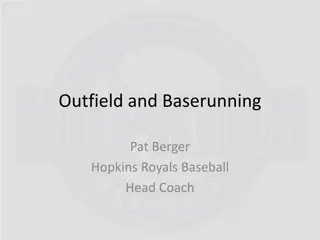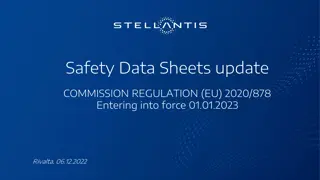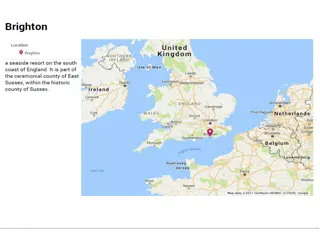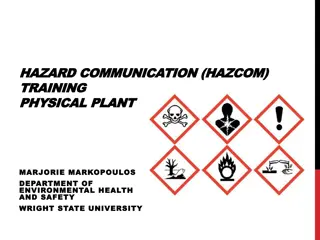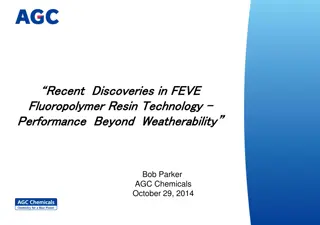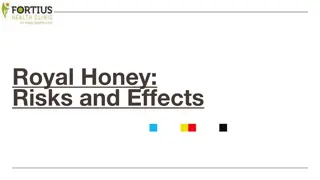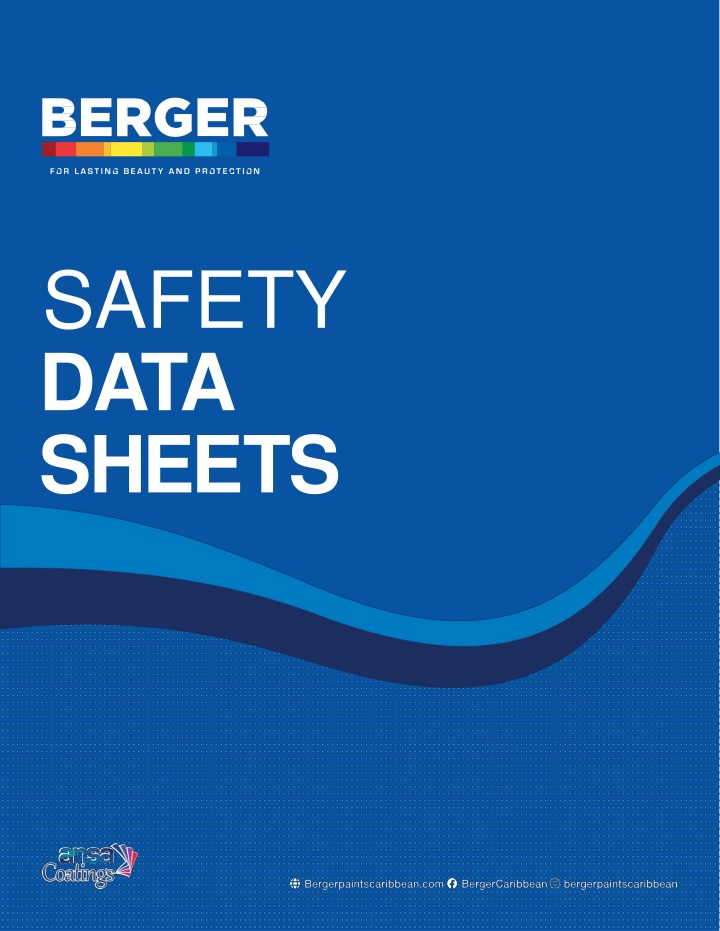
Safety Data Sheets - Berger Royal Royale Gloss
Find safety data sheets for Berger Royal Royale Gloss paint, including product identification, hazards, composition, and first aid measures. Stay informed and ensure safe handling of this product.
Download Presentation

Please find below an Image/Link to download the presentation.
The content on the website is provided AS IS for your information and personal use only. It may not be sold, licensed, or shared on other websites without obtaining consent from the author. If you encounter any issues during the download, it is possible that the publisher has removed the file from their server.
You are allowed to download the files provided on this website for personal or commercial use, subject to the condition that they are used lawfully. All files are the property of their respective owners.
The content on the website is provided AS IS for your information and personal use only. It may not be sold, licensed, or shared on other websites without obtaining consent from the author.
E N D
Presentation Transcript
SAFETY DATA SHEETS
DA TASHEETS: SAFETY BERGER ROYAL ROYALE GLOSS 1. IDENTIFICATION OF THE SUBSTANCE/MIXTURE AND OF THE COMPANY/ UNDERTAKING IDENTIFICATION OF THE SUBSTANCE OR MIXTURE Product name: Product code: Chemical name: Synonyms: Chemical formula: CAS number: ROYAL ROYALE GLOSS P113688 Not available Not available Not applicable Not applicable COMPANY/UNDERTAKING IDENTIFICATION Manufacturer/Supplier: ANSA MCAL INDUSTRIAL PARK, 51-59 TUMPUNA ROAD SOUTH, GUANAPO, ARIMA, TRINIDAD, W.I. TEL (868) 665-5721-3/4913/5829/8046/1991, 671-2722/ 3245 FAX (868) 665-1577 TRINIDAD TEL : 868) 665-5721-3/4913/5829/8046/1991, 671-2722/3245 FAX: (868) 665-1577 Emergency telephone number (with hours of operation): www.bergerpaintscaribbean.com PRODUCT INFORMATION 2. HAZARDS IDENTIFICATION Irritant, Dangerous for the environment R43- May cause sensitization by skin contact. R51/53- Toxic to aquatic organisms, may cause long-term adverse effects in the aquatic environment. May cause sensitization by skin contact. Toxic to aquatic organisms, may cause long-term adverse effects in the aquatic environment. None known. Classification: Risk phrases: Physical/chemical hazards: Human health hazards: Additional hazards: See Section 11 for more detailed information on health effects and symptoms. 3. COMPOSITION/INFORMATION ON INGREDIENTS Substance/preparation: Mixture Ingredient name CAS number % titanium dioxide 2-(2-butoxyethoxy)ethanol silicon dioxide diuron (ISO) Nonylphenol, ethoxylated carbendazim (ISO) octhilinone (ISO) reaction mass of: 5-chloro-2-methyl-4-isothiazolin- 3-one [EC no. 247-500-7] and 2-methyl-2H- isothiazol-3-one [EC no. 220-239-6] (3:1) 13463-67-7 112-34-5 7631-86-9 330-54-1 9016-45-9 10605-21-7 26530-20-1 55965-84-9 15-30 1-5 1-5 0-1 0-1 0-1 0-1 0-1 There are no additionalingredientspresentwhich,within thecurrent knowledgeof thesupplierandin the concentrations applicable, are classified as hazardous to health or the environment and hence require reporting in this section. Occupational exposure limits, if available, are listed in Section 8. 2
DA TASHEETS: SAFETY BERGER ROYAL ROYALE GLOSS 4. FIRST AID MEASURES INHALATION Remove victim to fresh air and keep at rest in a position comfortable for breathing. If not breathing, if breathing is irregular or if respiratory arrest occurs, provide artificial respiration or oxygen by trained personnel. It may be dangerous to the person providing aid to give mouth-to-mouth resuscitation. Get medical attention if adverse health effects persist or are severe. If unconscious, place in recovery position and get medical attention immediately. Maintain an open airway. Loosen tight clothing such as a collar, tie, belt or waistband.. INGESTION Wash out mouth with water. Remove dentures if any. Remove victim to fresh air and keep at rest in a position comfortable for breathing. If material has been swallowed and the exposed person is conscious, give small quantities of water to drink. Stop if the exposed person feels sick as vomiting may be dangerous. Do not induce vomiting unless directed to do so by medical personnel. If vomiting occurs, the head should be kept low so that vomit does not enter the lungs. Get medical attention if adverse health effects persist or are severe. Never give anything by mouth to an unconscious person. If unconscious, place in recovery position and get medical attention immediately. Maintain an open airway. Loosen tight clothing such as a collar, tie, belt or waistband. SKIN CONTACT Flush contaminated skin with plenty of water. Remove contaminated clothing and shoes. Wash contaminated clothing thoroughly with water before removing it, or wear gloves. Continue to rinse for at least 10 minutes. Get medical attention. In the event of any complaints or symptoms, avoid further exposure. Wash clothing before reuse. Clean shoes thoroughly before reuse. EYE CONTACT Immediately flush eyes with plenty of water, occasionally lifting the upper and lower eyelids. Check for and remove any contact lenses. Continue to rinse for at least 10 minutes. Get medical attention if irritation occurs. See Section 11 for more detailed information on health effects and symptoms. 5. FIRE-FIGHTING MEASURES EXTINGUISHING MEDIA Suitable: Not suitable: Recommended: alcohol-resistant foam, CO2, powders, water spray. Do not use water jet. SPECIAL EXPOSURE HAZARDS Combustible liquid. In a fire or if heated, a pressure increase will occur and the container may burst, with the risk of a subsequent explosion. Promptly isolate the scene by removing all persons from the vicinity of the incident if there is a fire. No action shall be taken involving any personal risk or without suitable training. Move containers from fire area if this can be done without risk. Use water spray to keep fire-exposed containers cool. This material is toxic to aquatic organisms. Fire water contaminated with this material must be contained and prevented from being discharged to any waterway, sewer or drain. Decomposition products may include the following materials: carbon dioxide, carbon monoxide, metal oxide/oxides. HAZARDOUS THERMAL DECOMPOSITION PRODUCTS Fire-fighters should wear appropriate protective equipment and self-contained breathing apparatus (SCBA) with a full face-piece operated in positive pressure mode. Clothing for fire-fighters (including helmets, protective boots and gloves) conforming to European standard EN 469 will provide a basic level of protection for chemical incidents. SPECIAL PROTECTIVE EQUIPMENT FOR FIRE-FIGHTERS 3
DA TASHEETS: SAFETY BERGER ROYAL ROYALE GLOSS 6. ACCIDENTAL RELEASE MEASURES PERSONAL PRECAUTIONS No action shall be taken involving any personal risk or without suitable training. Evacuate surrounding areas. Keep unnecessary and unprotected personnel from entering. Do not touch or walk through spilled material. Shut off all ignition sources. No flares, smoking or flames in hazard area. Avoid breathing vapor or mist. Provide adequate ventilation. Wear appropriate respirator when ventilation is inadequate. Put on appropriate personal protective equipment (see Section 8). Provide adequate ventilation. Wear appropriate respirator when ventilation is inadequate.Put on appropriate personal protectiveequipment (see Section 8). ENVIRONMENTAL PRECAUTIONS : Avoid dispersal of spilled material and runoff and contact with soil, waterways, drains and sewers. Inform the relevant authorities if the product has caused environmental pollution (sewers, waterways, soil or air). METHODSFORCLEANINGUP Small spill Stop leak if without risk. Move containers from spill area. Dilute with water and mop up if water-soluble. Alternatively, or if water-insoluble, absorb with an inert dry material and place in an appropriate waste disposal container. Use spark-proof tools and explosion-proof equipment. Dispose of via a licensed waste disposal contractor. Stop leak if without risk. Move containers from spill area. Approach release from upwind. Prevent entry into sewers, water courses, basements or confined areas. Wash spillages into an effluent treatment plant or proceed as follows. Contain and collect spillage with non-combustible, absorbent material e.g. sand, earth, vermiculite or diatomaceous earth and place in container for disposal according to local regulations. Use spark-proof tools and explosion-proof equipment. Dispose of via a licensed waste disposal contractor. Contaminated absorbent material may pose the same hazard as the spilled product. Large spill 7. HANDLING AND STORAGE HANDLING Put on appropriate personal protective equipment (see Section 8). Eating, drinking and smoking should be prohibited in areas where this material is handled, stored and processed. Workers should wash hands and face before eating, drinking and smoking. Remove contaminated clothing and protective equipment before entering eating areas. Persons with a history of skin sensitization problems should not be employed in any process in which this product is used. Do not get in eyes or on skin or clothing. Do not ingest. Avoid breathing vapor or mist. Avoid release to the environment. Refer to special instructions/safety data sheet. Use only with adequate ventilation. Wear appropriate respirator when ventilation is inadequate. Do not enter storage areas and confined spaces unless adequately ventilated. Keep in the original container or an approved alternative made from a compatible material, kept tightly closed when not in use. Store and use away from heat, sparks, open flame or any other ignition source. Use explosion-proof electrical (ventilating, lighting and material handling) equipment. Use non-sparking tools. Take precautionary measures against electrostatic discharges. To avoid fire or explosion, dissipate static electricity during transfer by grounding and bonding containers and equipment before transferring material. Empty containers retain product residue and can be hazardous. Do not reuse container. Store in accordance with local regulations. Store in a segregated and approved area. Store in original container protected from direct sunlight in a dry, cool and well-ventilated area, away from incompatible materials (see Section 10) and food and drink. Eliminate all ignition sources. Separate from oxidizing materials. Keep container tightly closed and sealed until ready for use. Containers that have been opened must be carefully resealed and kept upright to prevent leakage. Do not store in unlabeled containers. Use appropriate containment to avoid environmental contamination. STORAGE 4
DA TASHEETS: SAFETY BERGER ROYAL ROYALE GLOSS 8. EXPOSURE CONTROLS/PERSONAL PROTECTION EXPOSURELIMITVALUES INGREDIENT NAME OCCUPATIONAL EXPOSURE LIMITS ACGIH TLV (United States, 3/2012). TWA: 10 mg/m3 8 hours. titanium dioxide EU OEL (Europe, 12/2009). Notes: list of indicative occupational exposure limit values TWA: 67.5 mg/m3 8 hours. TWA: 10 ppm 8 hours. STEL: 101.2 mg/m3 15 minutes. STEL: 15 ppm 15 minutes. 2-(2-butoxyethoxy)ethanol ACGIH TLV (United States, 3/2012). TWA: 10 mg/m3 8 hours. diuron (ISO) ACGIH TLV (United States, 3/2012). TWA: 10 mg/m3 8 hours. OSHA PEL 1989 (United States, 3/1989). TWA: 10 mg/m3 8 hours. Form: Total dust OSHA PEL (United States, 6/2010). TWA: 15 mg/m3 8 hours. Form: Total dust titanium dioxide ACGIH TLV (United States, 3/2012). TWA: 10 ppm 8 hours. Form: Inhalable fraction and vapor . 2-(2-butoxyethoxy)ethanol silicon dioxide NIOSH REL (United States, 1/2013). TWA: 6 mg/m3 10 hours. 5
DA TASHEETS: SAFETY BERGER ROYAL ROYALE GLOSS 8. EXPOSURE CONTROLS/PERSONAL PROTECTION If this product contains ingredients with exposure limits, personal, workplace atmosphere or biological monitoring may be required to determine the effectiveness of the ventilation or other control measures and/or the necessity to use respiratory protective equipment. Reference should be made to monitoring standards, such as the following: European Standard EN 689 (Workplace atmospheres - Guidance for the assessment of exposure by inhalation to chemical agents for comparison with limit values and measurement strategy) European Standard EN 14042 (Workplace atmospheres - Guide for the application and use of procedures for the assessment of exposure to chemical and biological agents) European Standard EN 482 (Workplace atmospheres - General requirements for the performance of procedures for the measurement of chemical agents) Reference to national guidance documents for methods for the determination of hazardous substances will also be required. EXPOSURELIMITVALUES Use only with adequate ventilation. Use process enclosures, local exhaust ventilation or other engineering controls to keep worker exposure to airborne contaminants below any recommended or statutory limits. The engineering controls also need to keep gas, vapor or dust concentrations below any lower explosive limits. Use explosion-proof ventilation equipment. OCCUPATIONAL EXPOSURE CONTROLS HYGIENE MEASURES Wash hands, forearms and face thoroughly after handling chemical products, before eating, smoking and using the lavatory and at the end of the working period. Appropriate techniques should be used to remove potentially contaminated clothing. Contaminated work clothing should not be allowed out of the workplace. Wash contaminated clothing before reusing. Ensure that eyewash stations and safety showers are close to the workstation location. RESPIRATORY PROTECTION Use a properly fitted, air-purifying or air-fed respirator complying with an approved standard if a risk assessment indicates this is necessary. Respirator selection must be based on known or anticipated exposure levels, the hazards of the product and the safe working limits of the selected respirator. HAND PROTECTION Chemical-resistant, impervious gloves complying with an approved standard should be worn at all times when handling chemical products if a risk assessment indicates this is necessary. Considering the parameters specified by the glove manufacturer, check during use that the gloves are still retaining their protective properties. It should be noted that the time to breakthrough for any glove material may be different for different glove manufacturers. In the case of mixtures, consisting of several substances, the protection time of the gloves cannot be accurately estimated. EYE PROTECTION Safety eyewear complying with an approved standard should be used when a risk assessment indicates this is necessary to avoid exposure to liquid splashes, mists or dusts. If contact is possible, the following protection should be worn, unless the assessment indicates a higher degree of protection: safety glasses with side- shields. SKIN PROTECTION Personal protective equipment for the body should be selected based on the task being performed and the risks involved and should be approved by a specialist before handling this product. Emissions from ventilation or work process equipment should be checked to ensure they comply with the requirements of environmental protection legislation. In some cases, fume scrubbers, filters or engineering modifications to the process equipment will be necessary to reduce emissions to acceptable levels. ENVIRONMENTAL EXPOSURE CONTROLS 6
DA TASHEETS: SAFETY BERGER ROYAL ROYALE GLOSS 9. PHYSICAL AND CHEMICAL PROPERTIES Liquid. PHYSICAL STATE Not available. ODOR Not available. ODOR THRESHOLD Not available. PH Not available. BOILING POINT Not available. MELTINGPOINT FLASH POINT Closed cup: >61 C (>141.8 F) Not available. VAPOR PRESSURE Not available. SOLUBILITY Not available. VAPOR DENSITY Not available. AUTO-IGNITION TEMPERATURE DENSITY 1.21 g/cm3 Not available FLAMMABILITY 10. STABILITY AND REACTIVITY The product is stable. CHEMICAL STABILITY Under normal conditionsof storage and use, hazardousreactions will not occur. POSSIBILITYOF REACTIONS Avoidallpossiblesourcesof ignition(sparkorflame).Do notpressurize, cut,weld, braze, solder, drill, grind or expose containers to heat or sources of ignition. CONDITIONS TO AVOID No known incompatibility MATERIALS TO AVOID 7
DA TASHEETS: SAFETY BERGER ROYAL ROYALE GLOSS 11. TOXICOLOGICAL INFORMATION POTENTIAL ACUTE HEALTH EFFECTS Inhalation: Ingestion: Skin contact: Eye contact: No known significant effects or critical hazards.. No known significant effects or critical hazards. May cause skin irritation. May cause sensitization by skin contact. May cause eye irritation. PRODUCT/INGREDIENTNAME RESULT SPECIES SCORE EXPOSURE OBSERVATION titanium dioxide Skin - Mild irritant Human - 72 hour 300 milligrams Intermittent - Eyes Moderate irritant Eyes - Severe irritant - - - - - 2-(2-butoxyethoxy)ethanol Rabbit Rabbit - - 24 hours 20 milligrams 20 milligrams silicon dioxide Eyes Mild irritant Rabbit - 24 hours 25 milligrams Nonylphenol, ethoxylated Eyes - Severe irritant Eyes - Severe irritant Eyes - Severe irritant Skin - Mild irritant 20 milligrams 20 milligrams 20 milligrams 72 hours 15 milligrams Intermittent 500 milligrams - - - Guinea Pig Mouse Rabbit Human - - - - - Rabbit - Skin - Mild irritant Rabbit Human - - octhilinone (ISO) Reaction mass of : 5-chloro-2-methyl-4-isothiazolin-3-one [EC no. 247-500-7] and 2-methyl-2H- isothiazol-3-one [EC no. 220-239-6] (3:1) Eyes - Severe irritant Skin Severe Irritant 100 milligram 0.01 percent - - PRODUCT NAME CARCINOGENIC EFFECTS MUTAGENIC EFFECTS DEVELOPMENTAL EFFECTS FERTILITY EFFECTS diuron (ISO) carbendazim (ISO) Carc. Cat. 3; R40 Muta. Cat. 2; R46 Repr. Cat. 2; R61 Repr. Cat. 2; R60 Once sensitized, a severe allergic reaction may occur when subsequently exposed to very low levels. No known significant effects or critical hazards. No known significant effects or critical hazards. No known significant effects or critical hazards. No known significant effects or critical hazards. No known significant effects or critical hazards. No known significant effects or critical hazards. CHRONIC EFFECTS CARCINOGENICITY MUTAGENICITY TERATOGENICITY DEVELOPMENTAL EFFECTS FERTILITY EFFECTS DENMARK CARCINOGEN LIST OVER-EXPOSURE SIGNS/SYMPTOMS Inhalation Ingestion Skin Eyes : No specific data. : No specific data. : Adverse symptoms may include the following: irritation, redness : No specific data. 8
DA TASHEETS: SAFETY BERGER ROYAL ROYALE GLOSS 12. ECOLOGICAL INFORMATION Toxic to aquatic organisms, may cause long-term adverse effects in the aquatic ECOTOXICITY environment. . AQUATIC ECOTOXICITY Conclusion/Summary: Not available. BIOACCUMULATIVE POTENTIAL PRODUCT/ INGREDIENT NAME titanium dioxide 2-(2-butoxyethoxy)ethanol diuron (ISO) Nonylphenol, ethoxylated carbendazim (ISO) octhilinone (ISO) LOGPOW BCF POTENTIAL - 1 2.68 3.28 1.52 2.45 352 - 14.125375446 - 2.51 - High Low Low High Low Low No known significant effects or critical hazards. OTHER ADVERSE EFFECTS 13. DISPOSAL CONSIDERATIONS METHODS OF DISPOSAL The generation of waste should be avoided or minimized wherever possible. Waste product residues should not be disposed of via the sewer but processed in a suitable effluent treatment plant. Dispose of surplus and non-recyclable products via a licensed waste disposal contractor. Disposal of this product, solutions and any by-products should at all times comply with the requirements of environmental protection and waste disposal legislation and any regional local authority requirements. Waste packaging should be recycled. Incineration or landfill should only be considered when recycling is not feasible. This material and its container must be disposed of in a safe way. Care should be taken when handling emptied containers that have not been cleaned or rinsed out. Empty containers or liners may retain some product residues. Avoid dispersal of spilled material and runoff and contact with soil, waterways, drains and sewers. 14. TRANSPORT INFORMATION INTERNATIONAL TRANSPORT REGULATIONS International transport regulations This preparation is not classified as dangerous according to international transport regulations (ADR/RID, ADNR, IMDG and IATA ). Transport in accordance with ADR/RID, ADNR, IMDG and IATA and national regulation. Always transport in closed containers that are upright and secure. Ensure that persons transporting the product know what to do in the event of an accident or spillage 9
DA TASHEETS: SAFETY BERGER ROYAL ROYALE GLOSS 15. REGULATORY INFORMATION HAZARD SYMBOL OR SYMBOLS: Irritant, Dangerous for the environment R43- May cause sensitization by skin contact. R51/53- Toxic to aquatic organisms, may cause long-term adverse effects in the aquatic environment. . S2- Keep out of the reach of children. S24- Avoid contact with skin. S29- Do not empty into drains. S37- Wear suitable gloves. S46- If swallowed, seek medical advice immediately and show this container or label. S61- Avoid release to the environment. Refer to special instructions/safety data sheet. . RISK PHRASES SAFETY PHRASES CONTAINS reaction mass of: 5-chloro-2-methyl-4-isothiazolin-3-one [EC no. 247-500-7] and 2-methyl-2H-isothiazol-3-one [EC no. 220-239-6] (3:1) Consumer applications PRODUCT USE 16. OTHER INFORMATION NATIONAL FIRE PROTECTION ASSOCIATION (U.S.A.) Flammability 2 Health Instability / Reactivity 2 0 Special HISTORY Date of printing Date of issue Revision Date of previous issue Version 22-2-2015 01-12-2021 1 No previous validation 1 Indicates information that has changed from previously issued version. DISCLAIMER Information contained in this material safety data sheet is believed to be reliable and given in good faith, but no representation, guarantee or warranties of any kind are made as to its accuracy, suitability for a particular application or results to be obtained from them. The user of this material decides what safety measures are necessary to safely use this material, either alone or in combination with other materials. 10
SAFETY DATA SHEETS This an evolvingdocument and will be updated periodically as new products become available. For further support,please contact our corporate office: ANSA Coatings Limited (Head Office) Address: ANSA McAL Industrial Park, #51-59 Tumpuna Road, Guanapo, Arima,Trinidad.






